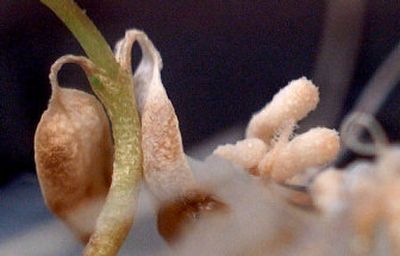Gene find may prevent pollution

A Washington State University researcher – along with other scientists from around the globe – may have found a fix for problems associated with nitrogen fertilizers.
B.W. “Joe” Poovaiah and his research team found the genetic mechanism that allows some plants to convert, or fix, nitrogen into food. Since staple crops like wheat and rice cannot fix nitrogen – as can peas and other legumes – they are fertilized heavily with nitrogen-rich materials that exact a heavy financial and environmental cost around the world.
Poovaiah’s work suggests that might end in the near future.
“It’s a huge step, as far as agriculture is concerned,” he said Thursday.
Poovaiah’s work was published Thursday in the scientific journal Nature, which published another paper by European and Japanese scientists who found similar results.
Both teams worked on manipulating a plant gene that was cloned by Poovaiah a decade ago. It’s the second Nature article he’s published in less than a year related to breakthroughs on the subject of plant growth and development.
His first article reported that he’d found the genetic trigger for controlling the height of plants, which could open the way for the development of smaller, more efficient crops in regions plagued by drought and hunger. The discoveries followed years of work, and Poovaiah said he sometimes wondered whether it would pay off.
“Now I feel the game is just beginning,” he said.
Legumes are able to fix nitrogen via nodules that form on their roots. Bacteria inside the nodules convert the nitrogen from the atmosphere into a usable form for the plants to consume.
Poovaiah and his team proved that the same gene exists in plants that do and do not fix nitrogen. They were able to manipulate it to make the plants produce nodules even without the presence of the bacteria.
Most non-legumes have the same gene and if that work can be reproduced in crops, the need for nitrogen-rich fertilizer could disappear. The crops would be able to form the symbiotic relationships with nitrogen and other microbes in an environmentally beneficial way, Poovaiah said.
Nitrogen pollution in surface water poses risks to the health of humans and marine life. Nature, in its article about the research papers, said about half of all fossil fuels burned for agriculture are related to the use of nitrogen fertilizer. WSU, in its news release about the findings, noted that nitrogen goes into groundwater and streams from fields, and can reach levels high enough to kill nearly everything in the water.
National Geographic reports that the amount of nitrogen in the world’s environment has doubled over the last century, primarily because of fertilizer use. Environmental groups have focused on the “dead zone” in the Gulf of Mexico, where marine life has been shut down primarily because of the 1.5 metric tons of fertilizer washed into the gulf every year by the Mississippi River.
While it’s still early in the discovery process, Poovaiah said publication of the two papers, which reinforce each other’s findings, is encouraging in terms of future development. He said it’s conceivable that the science might make it into farm fields within a decade.
“I don’t have a crystal ball to say how rapidly we can get to that point,” he said. “But I can see the light at the end of the tunnel.”